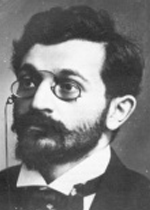Lasker Dr. Emanuel (24.12.1868 – 11.01.1941)
 German player, author, and journalist born in Poland and died in New York. The second World Champion (1894-1921). He studied mathematics and philosophy at the Universities of Berlin, Göttingen, and Erlangen and gained the title of “Ph.D.”, he lived from 1892 to 1907 in the USA and in England for some years, where he was an assistant lecturer at the Manchester Polytechnic.
German player, author, and journalist born in Poland and died in New York. The second World Champion (1894-1921). He studied mathematics and philosophy at the Universities of Berlin, Göttingen, and Erlangen and gained the title of “Ph.D.”, he lived from 1892 to 1907 in the USA and in England for some years, where he was an assistant lecturer at the Manchester Polytechnic.
He was taught to play chess by his brother Berthold at the age of 11, and he was totally absorbed with chess play. He was very talented in mathematics, and after finishing school in 1888, he returned to Berlin to enter the university. The same year he beat Curt von Bardeleben scored 2½-1½, +2=1-1 and Jacques Mieses 6½-1½, +5=3. He managed to improve his chess play so much that he received the German master title in the Hauptturnier in Breslau in 1889. In 1890 he played two matches: with Henri Bird he scored 8½-3½, and Berthold Englisch 3½-1½. Since 1888 he began to participate in the Berlin Chess Society tournaments and since 1889 started to play in international chess events.
His first international success was the first prize in 1892 in the London Tournament, followed by Joseph Blackburne; then Lasker played a match with him and won convincingly 8-2 and became the challenger. Staying in the USA in 1893 he defeated the American champion Jackson Showalter 7-3 and in 1894 had the -opportunity to play a match with the World Champion Wilhelm Steinitz, the score being 12-7, +10=4-5 in favor of Lasker. In 1895 at the very strong Hastings Tournament, he came in third after Nelson Pillsbury and Mikhail Chigorin and ahead of Wilhelm Steinitz and Siegbert Tarrasch. The next year he played a return match with Steinitz and won with a score of +10=5-2. In 1895-96 he won the Leningrad Tournament, being ahead of Steinitz, Pillsbury and Tchigorin, in 1896 he was the first at Nuremberg ahead of Geza Maroczy, Pillsbury, Tarrasch, Chigorin, and Steinitz, in 1899 he came in first in London, followed by David Janowski, Geza Maroczy and Nelson Pillsbury, in 1900 he performed first at Paris ahead of Nelson Pillsbury and Geza Maroczy. In 1900 he defended a thesis at Erlangen University and obtained a Doctorate. During four years he did not participate in any chess events, and in 1904 he played at Cambridge Springs and was the second equal with David Janowski after Frank Marshall. Since then he lived in the USA. In 1907 he played the title match with Frank Marshall and won 11½-3½. In 1908 he returned to Germany and beat Siegbert Tarrasch with a score of 10½-5½. Later in 1909-10 he played two matches with David Janowski and won the first match with a score of 8-2, and the second scoring 9½-1½. In 1910 he drew the match with Schlechter 5-5 and retained the title of World Champion. In 1911 he married Marta Kohn, a rich widow. In 1914 he won a historic tournament at St. Petersburg where Capablanca participated and he received the right for the title match with José Raúl Capablanca, but it was interrupted because of the outbreak of World War I. However, in 1921 José Raúl Capablanca defeated Lasker by a score of 5-9. In 1923, he won the tournament at Ostrava and also in 1924 at New York ahead of José Raúl Capablanca and Alexander Alekhine. He took part in several chess events, and in 1925, he was the second at Moscow in front of José Raúl Capablanca, behind Efim Bogoljubov, in 1934 he came in fifth at Zurich, and in 1935 he took the third place at Moscow in front of Mikhail Botvinnik and Salo Flohr followed by José Raúl Capablanca. In 1936 at Moscow he took the sixth place and the seventh place at Nottingham. His family was persecuted as a Jewish couple, and in 1933 he was exiled to England. In 1935 he emigrated to the USSR and lived in Moscow for two years but in 1937 he went back to the USA.
The last four years of his life he lived in New York. His style of play is characterized by great logic, a high technique of playing endings, and individual and psychological approach to his opponents, a fine tactic, and maneuvers. Alexander Alekhine said that some ideas of chess art were difficult to imagine without Lasker and he should be an example for modern and future generations of chess players.
During the period 1904-09, he was the editor of Lasker’s Chess Magazine and the author of some mathematical and philosophical works. Lasker published several books devoted to chess: Common Sense in Chess (1896-1924), containing a series of lectures, Der International Schachkongress zu St. Petersburg (1909), Meine Sechs Partien mit Dr. Tarrasch (1917), Mein Wettkampf mit Capablanca (1921), Lasker’s Manual of Chess (1925-1934), and Lasker’s Chess Primer (1934), The Return Match Alekhine v. Boguljubov (1934) with his views on chess, Struggle(1907), Das Begreifen der Welt (1913), Die Philosophie der Uunvollendbar(1917) and a sociological study, The Community of the Future (1940).








